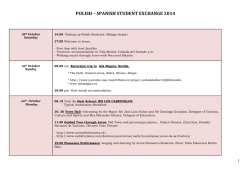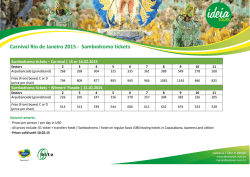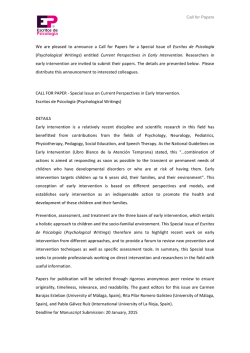
Tourist flows management in Málaga
Tourist Flows Management in Málaga Álvarez-Vidales, J., Perea-Medina,M.J. & Cerezo-Medina, A. FINAL PROJECT [TECHNICITY 2014] 1. Topic We analyze how the management of tourist flows in the city of Malaga could be improved with the use of ICTs. 2. What The objective of the project is to know how ICT could help collecting tourist flow´s data automatically, in other words, a tourist "flow measurement" system. This system includes elements as cameras with sensors, digital panels and mobile applications. This initiative will have benefits to all stakeholders. Tourist will optimize their time visiting the city avoiding crowds, in addition it will contribute positively on the well-being of the citizens and finally will help the local government in the decision making process. 3. Why On the one hand, there are studies1 that describe how the management of tourist flows in Málaga is inefficient, since there are a number of "hot spots" which are the most congested places and, on the other hand, some "cold spots" that, despite having potentials, are not in the main tourist routes due to a poor management of information. Málaga received 9.150.000 tourists in 2012, and it has four large “doors” of entry of tourists: Airport [6.253.952 passengers], AVE station [688.067 passengers], private vehicles and bus [around 1.550.000 tourists] and port [651.517 cruise passengers 2]. For the first three terms it is very complex to separate the number of tourists from the not tourists, but cruise passengers (excursionist), which are recorded in the fourth point of access are easier to identify. The tourists have a limited time to see the city, and this must be adapted to their needs, i. e., they require a system that allows them to visit more places in less time. We are talking about efficient management of flows that have an impact on the satisfaction of the tourist experience, and it has an impact on the local community satisfaction. 4. Where The project is located in the historic centre of Málaga (Andalusia, Spain). We decided this location because Málaga is the capital of the Costa del Sol and because the historic centre is an important focus of cultural and urban tourism. 1 2 García, S. (2013). Flujos turístico en destinos de ciudad. El caso de Málaga Capital. Trabajo Fin de Máster. Facultad de Turismo, Universidad de Málaga. Balance Turístico (2012). Málaga Costa del Sol. Patronato de Turismo de la Costa del Sol. Obtenido de http://profesional.visitacostadelsol.com/bd/ficheros.php?modulo=72 Tourist Flows Management in Málaga Álvarez-Vidales, J., Perea-Medina,M.J. & Cerezo-Medina, A. Larios Street Málaga Cathedral Alcazaba & Roman Theatre | | | | | | | | _Malagueta Bullring _Marina Square _Port of Málaga: Muelle Uno & Palmeral Map 1. Main tourist resources and its area of influence. Tourist Flows Management in Málaga Álvarez-Vidales, J., Perea-Medina,M.J. & Cerezo-Medina, A. 5. Who This project is designed not only for tourists who visit the city of Málaga, but also local citizens will be benefit by the technological solutions we propose. In addition, our project could help local Government to make better decisions regarding tourism. After our study, we can say that the Public Administration from the respective areas of tourism and technological development are interested in this project. Moreover, our project is innovative and it has a positive impact on the improvement of the city [social, technological and economic areas]. In addition, local businesses are interested in the app because they can incorporate advertising and content in it. We include another proposal for citizens and tourist: it includes feedback system information that allows them participate and share opinions about the different “points” of Málaga. For example, people can advice through the app if Larios Street is crowded or report about activities in other points of the city. With this feedback system, people can improve the tourist flows management with their contributions. 6. How a. Data Analysis We have worked with: The data of the tourist Observatory of Málaga, which are based on surveys throughout a year in the area of the historic centre of Málaga. They have followed a random routes methodology, which enables us to know the density of the different points of the city where tourists have been surveyed. The data used come from a large number of interviews (+3,600 people) carried out in 2010. The methodology is based on personal interviews and semi-structured questionnaires with open and closed questions. Other studies about Tourist Flows Management in Málaga. Fieldwork. Tourist Flows Management in Málaga Álvarez-Vidales, J., Perea-Medina,M.J. & Cerezo-Medina, A. Results: The data analysis allowed us to identify the most crowded places and design two maps. The first map shows the different areas with max and medium flows in Málaga and the second map shows the tourist potential places in the city. Place Flow “Paseo del Parque” Max Flow Marina Square Max Flow Larios Street Max Flow Constitución Square Max Flow Obispo Square Max Flow Granada Street Medium Flow San Agustín Street Medium Flow Gibralfaro Castle Medium Flow Alcazaba and Roman Theatre Medium Flow Merced Square Medium Flow Cervantes Street Medium Flow “Montes de Málaga” Natural Park Low Flow “Reading” Promenade Low Flow Guadalhorce River Low Flow “Soho” District Low Flow “Concepción” Botanic Garden Low Flow “Antonio Banderas” Promenade Low Flow Table 1. Tourist flows in Málaga. Tourist Flows Management in Málaga Álvarez-Vidales, J., Perea-Medina,M.J. & Cerezo-Medina, A. Map 2. Maximum and high congestion tourist areas in Málaga. Tourist Flows Management in Málaga Álvarez-Vidales, J., Perea-Medina,M.J. & Cerezo-Medina, A. Map 3. Potential tourist areas to develop in Málaga. Tourist Flows Management in Málaga Álvarez-Vidales, J., Perea-Medina,M.J. & Cerezo-Medina, A. b. Design The first step to create a tourist flows management system is setting the core according to the aims established in the proposal. The foundation of the system is the tourist information provided to all Málaga´s visitors which is the strategic element in tourism management as it affects the visitor´s behavior in the city. Tourist will decide whether or not visit certain points of interest conditioned by the tourist information received, which currently it´s quite simple because there is a lack of customization and the same brochure is distributed to all visitors independently of their motivations. Therefore the flows management system should provide the suitable information in the right moment, and that means information has to be customized and segmented by types of visitors. The project will have three key elements: detection flows system as the basis of the proposed model, the development of a mobile application and digital information panels. Crowd What’s on? User Alternative place. Efficient management of flows Data Control Center Graphic 1. Proposed system Tourist Flows Management in Málaga Álvarez-Vidales, J., Perea-Medina,M.J. & Cerezo-Medina, A. Concerning the data analysis, we decided to implement a system for the management of flows in the city [cameras, motion sensors or mobile network]. - Option 1: Cameras Image 1. Cameras. Source: http://www.fastcoexist.com/3025926/one-company-is-trying-to-count-and-track-all-of-new-york-citys-pedestrians - Option 2: Motion Sensors: Image 2. Motion Sensors. Source: www.illumin.usc.edu - Option 3: Mobile Network Image 3. Mobile Network. Source: www.tourgune.org Tourist Flows Management in Málaga Álvarez-Vidales, J., Perea-Medina,M.J. & Cerezo-Medina, A. 7. Final Product We develop a mobile application which provides an alternative route for tourists and a few digital information panels that provide real-time information in order to avoid crowding in hot spots of the city. On the other hand, the visibility of the cold spots will be increased because the application will offer alternative routes for these spaces. Mobile Application The main screen shows a short questionnaire about: personal detail (age, gender and companion) and preferences. The next screen details the best options according to your needs. Image 4. App Screenshots. Tourist Flows Management in Málaga Álvarez-Vidales, J., Perea-Medina,M.J. & Cerezo-Medina, A. Digital Information Panel After our research about tourist flows, we detected that Málaga Tourism Department is developing ten Digital Information Panels for the city. We believe this initiative could be adapted to our project. It would be necessary to implement a recommendation system in the panels because currently is not included. Tourist could synchronize with NFC Technology or Bluetooth their mobile app with these panels and it will show customized information and recommended routes. These panels will also provide: additional information (maps, detailed information about monuments, museums, schedules, public transports…); deals in restaurants, shops, activities; online shopping such as tickets; news. But the most important function of these panels is to show in real time a colored map of the tourist flows in the different areas of Málaga and offer alternative custom routes to avoid the crowds. Finally, the app and panels are constantly uploaded with the information collected by the tourist flows system (cameras, motion sensors or mobile network). Image 5. Digital information panels. Source: www.digitalavmagazine.com
© Copyright 2025


